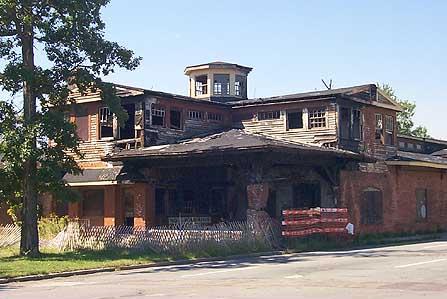DETROIT: HISTORICAL AND CULTURAL ISSUES
History
Detroit has a extremely rich and equally misunderstood history. The city has come a long way since its meager beginnings as Fort Pontchartrain. Detroit has been an important strategic possession for the French, the British, and finally the Americans. Beginning in the 1830's the city became an important final stop in the underground railroad, known as the "doorway to freedom." Detroit's growth was fostered by the completion of the Erie canal in 1825. By 1850 the population was 21,057, just 7 years later in 1857 the population boomed to 66,000. Detroit was well on its way to becoming to waterway to the west, a destination popular for many New Yorkers and was seen as more tolerant to Catholics than New England.
Detroit became important as a port city, shipping west many agricultural products (especially wool) in exchange for the manufactured goods of New England and Britain. The city was also quickly becoming more and more self-reliant. Tanneries, saw mills, breweries and other forms of manufacturing were beginning to take hold. I recommend a visit to the online "Streets of Detroit" virtual tour or even better, the exhibit at the Detroit Historical Museum.
The city got its first look at the machine that would come to change it forever on the evening of March 6, 1896. Charles Brady King drove his gasoline-powered carriage on a short eight block trip. Within 14 years the city's landscape and reputation would dramatically change, thanks to men like Ransom E. Olds, Henry Leland and Henry Ford who led Detroit on its path to become known as the "Motor City." Prosperous times were ahead for the fledgling city. By 1910 it had climbed 4 spots to become the 9th largest city in the U.S. Industry in Detroit had taken off, and the auto industry lead the way. Poles, Italians, Russians and Hungarians joined the ranks of Irish and Germans who worked non-union industrial jobs.
One attraction popular with many Detroiters at the turn of the century was Belle Isle, which boasted a new bathhouse, zoo and aquarium (third largest in the world at the time). In the bustling downtown residents could attend one of more than 40 theaters ranging from moving pictures to vaudeville. Even the Tigers were doing well at this time, winning three consecutive American League Championships in a row, thanks in part to an uncouth Mr. Ty Cobb.
Detroit was also home to the world's first Hudson's store in 1881. As the store prospered and continued to change American shopping patterns J.L. Hudson added a new store on Woodward in conjunction with the original on Jefferson. By the 1950s Hudson's would expand its base to the outlying suburbs in a totally new form, the mall, but these outlying satellites were no match for the massive Hudson's building on Woodward.
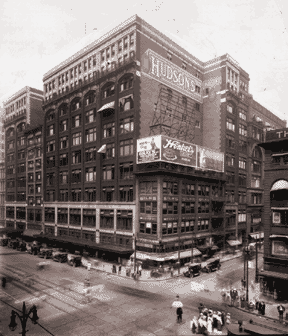
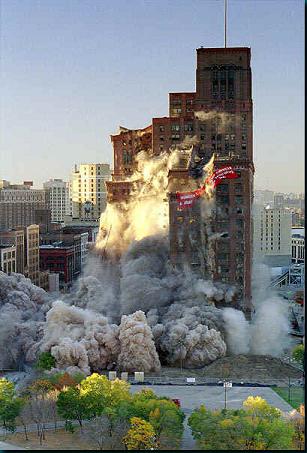
Source: The Fabulous Ruins of Detroit, detroityes.com
The first Hudson's store, circa 1911 & the eventual destruction of the landmark
One popular place to visit still is the Michigan Central Station, or MCS. Built but never fully utilized, it was rumored the towers were to become a hotel. The building was heavily looted and stripped of much of its beauty, including its origional marble floors, but still remains as a landmark of the Detroit that was the one that never fully materialized. Built before the time of the automobile MCS was a virtual island. Planners hoped to utilize streetcars to move travelers to and from the station, but as the depression hit streetcar service was eliminated and the station once again became isolated.
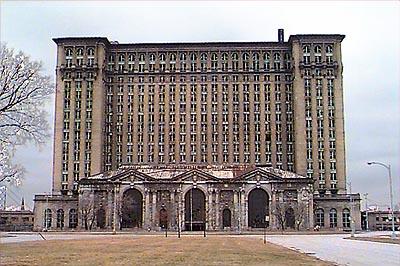
Source: The Fabulous Ruins of Detroit, detroityes.com
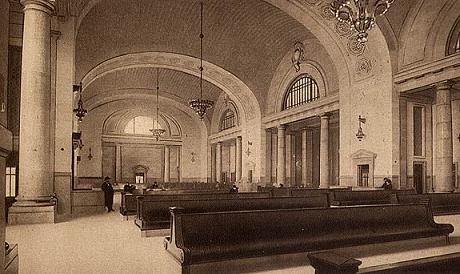
Source: The Fabulous Ruins of Detroit, detroityes.com
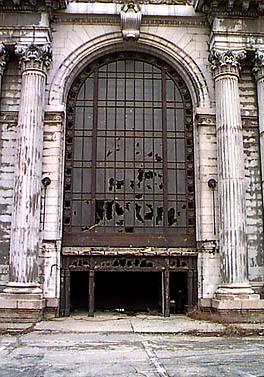
Source: The Fabulous Ruins of Detroit, detroityes.com
Prohibition was big business for Detroit. Rummies and the 18th Amendment meant late night runs across the Detroit river to obtain liquor. Lots of articles can be on the internet relating to bootleggers and Detroit's very own Purple gang.
August 28, 1963 was the day Martin Luther King Jr. stepped forth on the steps of the Lincoln memorial and delivered his "I have a dream" speech. Not everyone is aware, however, that Dr. King had spoke these words once before, just a few months prior on Woodward Ave in Detroit. It was June 23, the speech in it's entirety can be found (and listened to) at this link. Detroit had many social issues, specifically race relations, that needed desperate attention. Issues of racism and discrimination and unfortunately provided to the abandonment of certain parts of Detroit and is part of the cause of urban sprawl.
Causes
Two major race riots have had lasting effects on the city of Detroit. The riots of 1943 can be seen as a clash between whites and the new influx of southern blacks competing for resources. Housing, transportation and education were just three of the major sources of conflict between the two races. Housing was difficult to come by in W.W. II era Detroit and blacks were confined exclusively to the Brewster projects. The riots of '43 pale in comparison in both size and significance to the riots of 1967. According to one website, "The origins of urban unrest in Detroit were rooted in a multitude of political, economic, and social factors including police abuse, lack of affordable housing, urban renewal projects, economic inequality, black militancy, and rapid demographic change." The race riots of 1967 brought the problems many blacks faced everyday to the national spotlight.
Beginning with the elaborate designs of highway systems of the Eisenhower era, fleeing to the suburbs for a different life became an increasingly more popular option. Whites who could afford to moved in droves throughout the late 50s and well into the 60s to the suburbs to escape traffic, crime and racial problems. Outright fear of blacks and increased levels of racial tension only made the suburban life more lucrative.
Roads are costly to maintain and Detroit has neither the time nor the money to focus on maintaining them. Combine this with the millions upon millions it will cost to maintain other types of rapidly aging infrastructure and you have one bankrupt city. Waterpipes, Horizontal development is not only a waste of resources but in the long run causes unforeseen consequences.
It was the original hope of city planners than horizontal expansion would be a good thing. On paper it looked like a good way to increase the tax base and promote growth and development. But people did not spend their time or their money in Detroit or the older satellite communities and expansion moved farther and farther away. Contrast Troy with Detroit, notice a difference? Not only have people left Detroit but businesses have as well.
Effects, Summary and Solutions
The biggest problem is the outlying suburbs build during the first wave. These buildings are not as architecturally prominent and often leave visual blemishes on the landscape. Called brownfields, creating redevelopment in these areas is even more difficult than in the city itself.
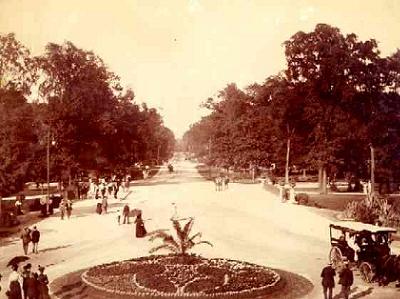
Source: The Fabulous Ruins of Detroit, detroityes.com
Belle Isle in 1890 and as it stands today.
As life became more and more dependant upon the car cities became less and less walkable. Walkability, according to Dr. Vojnovic, is the best indicator of a cities health. Buildings should be close to the street, streets should not have wide lanes difficult for pedestrians to cross. Contrast the development with Detroit with that of Portland of Minneapolis who strives to maintain a walkable city and sets growth boundaries to stimulate redevelopment. The problem is too many cities look to development as a solution to increasing the tax base and pay for much of the cost of the new development (Building roads and infrastructure, maintaining artifically cheap gas prices, allowing developers to capitalize on cheap land to make a quick buck).
Healthy cities utilize mixed use zoning. Past city planning separated residential, commercial and industrial development. More and more we are seeing signs that separating people from their workplaces via suburbs is not always the right answer. This website is not meant to come across as anti-development or anti-suburbs. Rather, it is to bring to light alternative methods of development. Re-development is always healthy. Maintaining a healthy city means not overextending infrastructure. Smart communities share municipal resources and attempt to expand and maintain transportation choices.
Reasons to be positive
I would like to start this section with all that Detroit still has to offer. The city is diverse and is awaiting to be discovered by a whole new generation. Abandoned in the past, Detroit has risen in the past few decades as a powerful and curious place for the counter culture to express itself.
Major League Sporting Teams
Detroit hosts the Superbowl 2006 at Ford Field and Baseball's Allstar Game at Comerica
Detroit Institute of Art - Amazing works of art, recommended donation is under $5.00
Woodward Dream Cruise - World's largest one-day celebration of car culture, over 1.7 million visitors, over 40,000 cars
Underground Art & Music
[Heidelberg.jpg]
Hart Plaza - Along the waterfront right near Cobo, Hart Plaza is the site of many cultural attractions such as the Detroit Electronic Music Festival and Martin Luther King Day celebrations
St. Andrews/Shelter, State Theater and More - Lots of great bands can be seen at these venues for fairly cheap ticket prices
Hubbard Farms - A downtown redevelopment project with housing dating back to the turn of the century. No one group dominates this area as Hubbard Farms houses both young and old or all different races and backgrounds.
It makes sense that Detroit would have issues dealing with sprawl. The city was built by and modeled for the use of automobiles. The American ideal of a personal space of their own and the right to choose has derailed mass transit hopes for the city, as well as most other cities in the United States. Look to cities like Detroit and you will see how Americans love their privacy: personal vehicles, gated communities, yards too big to mow but too small to farm, at a time in history where we should feel more interconnected than ever we feel more and more alienated from each other and even from ourselves.
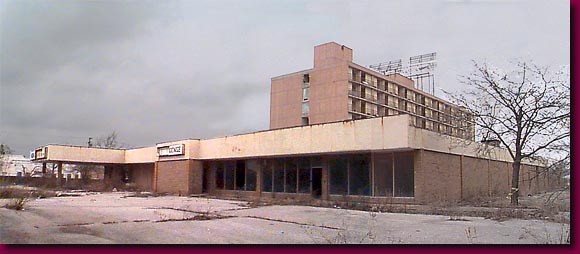
Source: The Fabulous Ruins of Detroit, detroityes.com
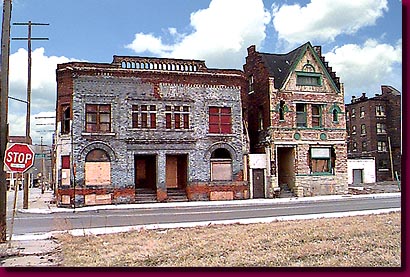
Source: The Fabulous Ruins of Detroit, detroityes.com
|
Visually stimulating, lots of content |
|
|
|
Check out the Table of Contents or Tour the Ruins |
||
|
Useful if renting a place of your own or seeing urban renewal in progress |
||
If you are interested in learning more I recommend the following books:
Once There Were Greenfields: How Urban Sprawl Is Undermining Americas's Environment,
Economy, and Social Fabric (Paperback)
F. Kaid Benfield, Matthew Raimi, Donald D. T. Chen
Asphalt Nation: How the Automobile Took over America, and How We Can Take It Back (Paperback) Jane Holtz Kay
Suburban Nation: The Rise of Sprawl and the Decline of the American Dream (Paperback) Andres Duany, Elizabeth Plater-Zyberk, Jeff Speck
Disclaimer: Much of the content was borrowed with permission from DetroitYes.com I highly recommend you tour the site, it includes a tour of the ruins and much more. I recommend starting with the Table of Contents section first.
Page created by Scott Davis, a GEO 333 student
This material has been compiled for educational use only, and may not be reproduced without permission. One copy may be printed for personal use. Please contact Randall Schaetzl (soils@msu.edu) for more information or permissions.
